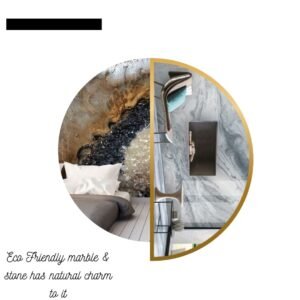What Is Marble Flooring? The Ultimate Guide to Everything You Need to Know
Vinyl, wood, and tile are some of the more obvious choices while planning the floors for your home. But if you have the budget to spare, your tastes might run to a more timeless upgrade that exudes both luxury and sophistication. This chic material in question is none other than marble. Depending on your pattern and color, your marble flooring can be just the statement piece your home needs.
Wondering what you should know about before investing in marble floor tiles? Well, your search ends here! Read on to know all about the different types of marble flooring.
What Is Marble Flooring?
You may already be familiar with what marble flooring looks like, but what exactly is this material about? Marble is a metamorphic stone that’s available in a variety of colors.
However, lighter-colored marble is more common, as it is naturally formed from limestone with a small amount of impurity that imparts a distinct color to it.
This natural stone ranges from white, dusty pink, grey, dark green, and even black.

What Are the Advantages and Disadvantages of Marble Flooring?
| Advantages | Disadvantages |
| Aesthetics: You can pick from a wide range of marble floor colors, vein patterns, and grains to find the perfect fit for your home. Moreover, each slab of stone has its unique veining. | Difficult to maintain: Stone is porous, making it easy to stain. You will need to polish and seal your marble flooring regularly to protect it from damage. |
| Longevity: These floors typically do not require changing and can last a lifetime. This stone might be high maintenance, but with the right care, it will see your house through an exceptionally long time. | Fragile: Marble flooring is susceptible to damage from regular items – soil and sand, fruit juices, coffee, wine, and even water. Moreover, without proper sealing, it can crack or chip easily. |
| Heat resistance: Marble can withstand high temperatures while staying cool to the touch. You can safely use it in your kitchen without too much of a wry. | Expensive: Quality marble can be expensive to install and maintain. |
| Allergy-proof: If you’re worried about multiple allergens or bacteria breeding on the floors of your home, marble is the best choice for you. This stone prevents the breeding of both bacteria and allergens. | Slippery: If you live in a multigenerational home, marble may not be ideal for kids and the elderly, as it’s slippery. |
| Resale value: Given the durability and longevity of marble, it can help increase your home’s resale |
What Marble Floor Colours and Types Are Available?
There are various types of marble flooring available in the market. While they might appear similar to the untrained eye, experts distinguish them based on differedifferencesins and vein patterns. Some common types of marble flooring include:
- Carrara Marble: One of the commonly used marbles in home interiors, this option is quarried in the Italian city of Carrara. It’s typically white, grey, or bluish-grey, with linear veining. The veins are characterized by small, fine lines or soft, feathery ones. An occasional dramatic vein pattern is, however, not unusual. You will often see this in building decor and sculptures.
- Statuario Marble: This variety of Italian marble flooring has a uniform background with light grey hues and more dramatic veins. It tends to reflect light, which can make the room look brighter. Though commonly used as flooring in spaces with low foot traffic, you can also use it in kitchen countertops.
- Calacatta Marble: Another modern marble flooring design from Italy, this option is a rarity. It’s identified by white marble with dark veins that form large, thick patterns, setting it apart from the other types. Often considered a luxury marble because of its rarity, this stone finds use in bathroom and kitchen flooring. However, due to its porous nature, it’s best avoided on kitchen countertops.
- Emperador Marble: Quarried from Spain, this stone comes in a variety of shades of brown. It stands apart with fine grains and irregular veining. It tends to be darker, making it a great choice for high-traffic areas.
- Crema Marfil Marble: Another marble quarried in Spain, this stone is available in several tones. The most commonly known tiles are light beige or yellow, with a uniform background. However, the veining in this type differs in intensity and can be irregular. It’s commonly used in exterior cladding, floors, and other decorations.
- Rough Marble Flooring: Apart from all these popular options, rough marble flooring is also becoming popular in households with elderly people. This type of marble flooring is used mostly in bathrooms, as it helps create anti-slip surfaces.
- Talathello Marble: Also known as silver-beige marble, this type of marble tile is quarried from Turkey. It has a chic brownish-grey coloring and can either be paired with warm- or cool-toned interiors.
- Levadia Marble: This material can be the best marble floor design for lovers of monochrome. Quarried in Greece, Levadia marble is black with thin white veining.
- Nero Marquina Marble: Another contender from Spain, the Nero Marquina marble is a luxurious black bituminous stone. In terms of appearance, it’s similar to Levadia marble and can also be best styled in monochromatic interiors.
- Bianco Lasa: If thick veins aren’t your thing, you might like the look of Bianco Lasa marble flooring. This stone has thin veins, complemented by a trendy neutral base that’s sure to suit any modern home.
- Boticcino Marble: Characterised by white veins, this classy marble originates from the Italian Alps. Consider using it in your bathroom or kitchen to curate an opulent theme.
Where Can You Use Marble at Home?
Marble floors cut down on the need for accent pieces by highlighting the very ground you walk on. Its heat-resistant nature makes marble the perfect choice for the kitchen, or even a fireplace.
With proper sealing and marble floor polish, you can help this porous stone become water-resistant. You can even use it in your bathrooms! Needless to say, it works well in different rooms of the house.
Since marble gets its glossy appearance by polishing it, you can opt to use it in areas of your home with low footfall, to reduce wear and tear. This keeps your home gorgeous for a longer period!
However, marble floor polishing can make it slippery. So, if you have children or elderly relatives at home, this could be a recipe for disaster. If you still want the material, though, you can opt for rough marble flooring, which isn’t slippery.
What Design Styles Best Complement Marble Flooring?
The timeless nature of these floors makes them suitable for any home. However, if you’re looking for design styles that match it, both classical and contemporary interiors work perfectly. Interiors that are high on luxury are also great places for marble flooring.
And if you thought marble flooring is a bit too grandiose for your minimalist home, think again! Since minimalist design is all about making the most with limited elements, you can opt for marble floors that make a bold statement on their own.
How to Maintain Marble Flooring?
Being porous, marble is often considered difficult to maintain. But don’t accept this as fact and deprive yourself of elevating your space with the material. While it’s true that this flooring is susceptible to stains, even from tea, coffee, and fruit juices, you can still have pristine floors despite this! Here’s how to maintain marble flooring in its best condition:
- Regular cleaning: The best answer to how to maintain the quality of your marble floors lies in regular cleaning. Use a soft cloth or a mop to clean your floors and prevent a build-up of dust and grime. Choose mild cleaning products and steer clear of acids and alkaline detergents that risk damaging the stone.
- Cleaning up spills: In case of a liquid spill, clean the stain as soon as possible to prevent it from leaving a lasting mark. If not, sprinkle baking soda on your marble surface and wipe it away with a clean damp cloth. Be careful not to use abrasive materials that can leave scratch marks.
- Sealing the floors: Use a floor sealant to protect your floors from accidental spills and stains. Sealants form a protective layer over the natural stone and prevent direct exposure to potentially harmful solvents. For marble flooring in kitchens or bathrooms, a sealant becomes a necessity to avoid the seepage of water.
- Polishing: This enhances the natural glow of marble while simultaneously reducing its absorbency. So, go ahead and choose marble floor polish to make your floors easier to maintain. However, this process may cause the thinning of marble, so ensure that you let the right amount of time pass before re-polishing.
Also, remember that the delicate nature of marble makes it susceptible to damage from even the soles of your shoes. Be sure to place a doormat made of soft cloth at the entrance of your home to minimize the amount of dirt carried into your home from the outside.
About the Author
About the Author Hi, I am D.C. Bhandari, chairman of Bhandari Marble Group living in India, Rajasthan, Kishangarh. I love seeing the new and creative ways people use our Marble, Granite, and Natural Stone. Our customers are so creative. My favorite design style is a preppy traditional mix with modern especially pieces that can be found in a vintage or antique stone. I like to invent travel, search, and experiment with natural stone products. For more posts visit our website.

WORLD’S TOP AND INDIA’S BEST MARBLE, GRANITE, AND STONE COMPANY
ADD BY EXPERT AND EXPORT TEAM OF BHANDARI MARBLE GROUP. CONTACT US AT: +919829040013



